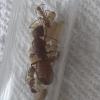Caught three of these parasitic Lasius latipes queens, they were flying with other Lasius spp.
8/17-20/16
They were very rambunctious in their test tubes, so I decide to release one and watch it to see what it would do. It walked around on my back patio for about 10 minutes and tried to enter various cracks in the paving stones. She got attacked by smaller worker ants (I am not sure what species they were) and eventually ran away from them and found a preexisting hole and she climbed down.
I decide to try and fill one of the other two's test tubes with dirt to see if she'd dig. She didn't she just kept trying to climb out of the test tube. I decided to release her. I watched her do similar things as the first girl I released and realized that she too climbed down a preexisting hole.
I had the third in a very large test tube that is about a foot long and 2 inches in diameter (it was the last one I had when I caught them all and the others were in 150mm long test tubes). I decided to fill her test tube partially with dirt. I then used a paint brush to push down through the dirt to the cotton ball that held back the water. I put her back into her test tube. She ran around for a minute and then climbed down the hole.
I read that they needed workers from another colony (plus the fact that the released queens entered preexisting colonies made me assume she would need help with her brood). I dug up an ant nest and took some of the brood and gave it to her.
I was impatient so I decided to also try and introduce her to a worker too. The worker climbed down the hole and they met and seemed okay. The worker climbed out and I watched them for a good bit to make sure they wouldn't fight. I tried the chilling in the fridge method too just to help keep the worker calm.
8/25/16
I checked on the queen and her worker. Mold has grown on the surface of the soil and I saw the worker outside of the hole on the roof of the test tube (because of the sheer size of the test tube it is kept vertical and not horizontal like the rest). I get an odd feeling about this and I see some of the brood moved from the bottom of the hole I dug to various places in the test tube including along the tunnel. I also can't see my queen.
I decide to dig her out. This was kind of an impulsive decision that I thought I would regret. I dug and dug and poured the dirt out onto our outdoor patio table. I checked very thoroughly for any sign of my L. latipes queen. After I took all of the dirt out there was still no sign of her. I check the dirt pile more and find a little red limb... I then found her head, several more limbs, and her gaster
8/28/16
The Lasius were flying again and I caught 3 more Lasius latipes queens. Time to try this again with much more patience. They are all currently in test tubes.
Edited by SaintDrake, September 7 2016 - 7:14 AM.


















